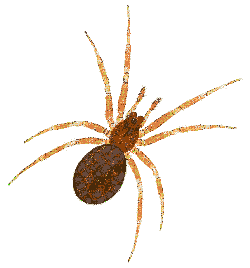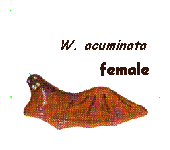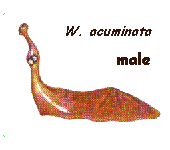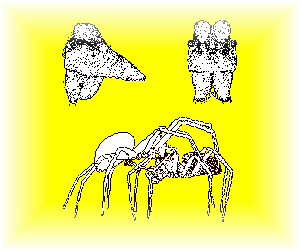


If you take a sideways look at the female's cephalothorax, you can see that her head is raised into a slight point - which is quite unusual for a linyphiid female.
But then look at the male's cephalothorax. Isn't that amazing? The eyes are raised up on a long vertical tower - almost reminiscent of a periscope! Even juvenile males have the front of the head raised into a smaller version of the adult structure and this unique feature makes male W. acuminata very easy to identify.

What could possibly be the function of such a bizarre structure?
In some texts, such as the main identification references prior to
Roberts (1985) [e.g. Locket, G.H. & Millidge, A.F. (1951 & 1953)
British Spiders vols I and II, published by the Ray Society] the family
Linyphiidae are divided into two subfamilies: Erigoninae and Linyphiinae.
Nowadays, as indicated in Roberts (1985), this is not regarded as phylogenetically
useful and the taxonomy of the Linyphiidae remains difficult to ascertain.
However, in practical terms I have found it useful as a rough indicator
of ecological aspects of the species. Last month's
species, Bolyphantes luteolus, is a good example of the Linyphiinae.
While linyphiines tend to be more active higher in the vegetation and on
the surface of leaf litter and moss, with their small sheet-webs in fairly
obvious positions, the erigonines are rather more cryptic and move around
deeper within leaf litter of woods, within moss of wet habitats or near
the soil surface in grasslands. It's tempting (but almost certainly wrong)
to imagine the male W. acuminata using their periscopic eyes to
"peep" over the leaves in woodland litter and see where they are going!
This is pure fantasy - but if you know more about it, please
let me know.
There are several other erigonine species in which the males have specialised
head structures; a few are provided for your view, if you wish. The females
are relatively uninteresting to look at, without these remarkably elaborated
heads.
Sometimes, these strangely shaped heads are provided with many hairs
which have associated secretory glands. They only occur in males and a
reasonable interpretation is that these structures are involved in the
release of pheromones - chemicals that influence the behaviour of the females.
The associated protruberances and pits on these heads serve to increase
their surface area.

But just look at the next picture, which graphically shows how another
linyphiid species, Hypomma bituberculatum, uses the male's oddly-shaped
head, seen here in lateral (from the side) and frontal view. As part of
their courtship and mating behaviour, the female takes a firm grip with
her chelicerae (fangs) on the two prominent tubercles on top of her mate's
head - you didn't know spiders have "love handles" did you?
While she is holding him in position, he uses each of his palps in
turn, inserting it into her epgigynal opening for the transmission of seminal
fluid. You can make this out in this picture, in which the male is the
darker individual. For further details of the mating behaviour of this
species, I refer you to Bristowe, W.S. (1958) The World of Spiders,
published by Collins, from which the image here is adapted.
The pictures of W. acuminata are adapted from Dr. Mike
Roberts' book : The Spiders of Great Britain and Ireland, published
by Harley Books in 1985, and the erigonine heads are highly modified from
the illustration in his extremely useful field guide: the Collins
Field Guide: Spiders of Britain & Northern Europe, by Michael J.
Roberts (1995), published by HarperCollins Publishers.
| Return to..? | |
 Ariadne Home Page
Ariadne Home Page |
|